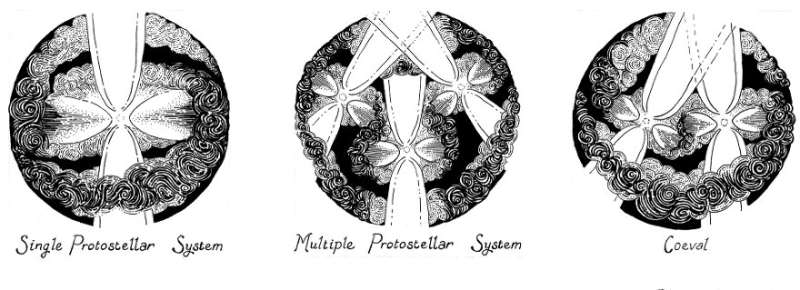How multiple star systems evolve

Sirius is not a single star at all, but a binary system of two stars. Polaris, the north star, is actually a system of three stars. And Castor, in the constellation of Gemini, actually consists of a whopping six stars. Current models show stars forming by the fragmentation of massive interstellar gas clouds, spinning themselves by gravity into stardom, in isolation and unaffected by nearby stars. But the plethora of systems in our galaxy that consist of multiple stars now has astronomers wondering why stars so often come in groups.
At Leiden Observatory in the Huygens Laboratory building, PhD student Nadia Murillo is looking at data gathered by (among others) ALMA, an array of sixty-six 12 meter radio telescopes in the Chajnantor valley, Chile. She's observing the very early stages of star formation in a region of the galaxy known as the Gould belt. Positioned at some 325 light-years away, it's a prime location to find out what leads to gas clouds fragmenting into young star systems.
Murillo: "We know that fragmentation of gas clouds occurs, and that clouds can fragment into systems of mutiple stars, because we can see the final result. But we're not sure yet what causes and influences the fragmentation of clouds. Why are there single stars forming in some places and multiples in others?"
This is the main question that Murillo wants to answer in her thesis. The answers are surprising. "Disc formation around stars has turned out to be important in the early stages of star formation, as discs can eventually fragment and form multiple star systems. Furthermore, what could have started as a binary star can end up with a disc that fragments and then turns into multiple stars. This all affects how a given systems ends up looking."
"We analyse the chemical structure of a given system, knowing that there are molecules that occur in cold regions and ones that occur in warm regions. Looking at their distribution allows us to model the physical and chemical structure of young stars and their influence on the surrounding material, telling us what systems actually look like."
Murillo's thesis research has changed the way she sees astronomy, modeling, and chemistry. "I once had a somewhat black-box view of some parts of the field, but it quickly turned out not to be as difficult or as out of reach as I thought. I now work together with lab scientists, modelers and observers to find out what's causing star systems to form."
In her research, Murillo took a multidisciplinary approach. "Sometimes we rely too much on models, sometimes too much on observations, or theory. It is important to consider all three - to cast a broader gaze. Earlier models and simulations have suggested that temperature could be an important factor in star formation, making the difference between clouds fragmenting and not fragmenting. We studied different molecules in cold and warm gas and compared their presence in single, binary and multiple young stars known as protostars. We didn't find any difference in the temperatures of the protostars, but we do find what seems to be a relation with mass."
"My thesis is a tiny piece of the big picture of star formation. Right now, models show stars in isolation, forming in a vacuum - and that is rarely the case. Current theories and models need to be adapted to include multiplicity, and until we do so, the big picture is incomplete."
Provided by Leiden University





















